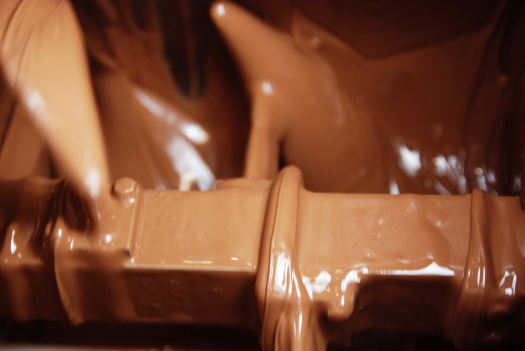Conching – a key step in chocolate manufacture

Conching is one of the most important steps in chocolate production. The process removes water and undesired flavors and develops the texture of the chocolate mass. The starting material are the so-called cocoa flakes, a rolled mixture of sugar and cocoa liquor. Within the flakes the cocoa butter naturally contained in the cocoa liquor is trapped by cocoa and sugar particles, meaning the mixture is dry and crumbly. The flakes are mechanically processed in the conche and become hot. The shear forces generate temperatures of up to 90°C and release cocoa butter which increasingly coats the cocoa and sugar particles. This alters the texture, with a transition from dry conching to plastic conching, and the mixture taking on a viscous, plastic consistency. The addition of cocoa butter liquifies the mixture and creates the final chocolate. The overall conching process can thus be split into three phases – the starting dry phase, the plastic phase, and the liquid phase. The most important phase is the plastic phase which involves the greatest shear forces and the texture and flavor development. The conching is a very time-consuming and costly step in chocolate manufacture but is still not adequately understood. In order to develop new formulations, the duration and intensity of the conching is currently evaluated on a case by case basis. As too long or too short conching has a particularly adverse impact on the flavor, this approach generates many reject batches. Improved prediction of effective conching conditions would thus have considerable economic significance.
Model-based conching to improve flavor and resource efficiency
The objective of the model-based conching project is to develop a model for predicting how the flavor profile of dark chocolate changes with time. The model will describe the distribution of selected flavor compounds in cocoa particles, cocoa butter, sugar particles, and the surrounding air. The raw materials will be characterized by, amongst things, molecular dynamics and flavor analysis. This requires determination of the partition coefficients and mass transfer coefficients of selected flavors and their starting concentrations in the raw materials. The flavor development with time will also be analyzed under real conching conditions. Tastings will enable sensory correlation of the chocolate products with the different conching parameters that include the temperature, energy input, and duration of the conching. The incorporation of experimental data into the model should allow prediction of suitable process and technological parameters. This should minimize the time and cost of development work and the number of reject batches. SMEs will particularly benefit from the project results, enabling them to develop new formulations faster and at lower cost.
Flavor analysis and physical characterization
A number of studies, including by the Fraunhofer IVV, have already been conducted on different conching conditions and the effect on chocolate flavor. These data do not, however, provide sufficient insight into how the flavor varies with time which is needed for modeling the conching process. The effect of different parameters on the flavor profile of dark chocolate will be investigated in the project using the laboratory and small pilot plant facilities at the Fraunhofer IVV. Samples will be generated under different conching conditions in a pilot plant conche and selected flavor compounds will be quantified by stable isotope dilution analysis and coupled gas chromatography - mass spectrometry. The physical characterization of the sample mass involves density and viscosity measurements. In addition, the water removal as a function of time will be investigated. This strategy will enable the physical changes and flavor compound transfer between the cocoa particles, cocoa butter, and surrounding air to be studied. The results will give improved understanding of substance transfer during the conching of dark chocolate and provide the basis for predicting suitable process parameters.
Project term: |
2018 to 2021 |
Funding programme: |
Programme for promoting the Industrial Collective Research (IGF) |
Project management/ funding: |
Arbeitsgemeinschaft industrieller Forschung AiF (via Research Group of the Food Industry FEI) / Federal Ministry of Economics and Energy BMWi |
Project partners: |
Technical University of Munich, Chair of Process Systems Engineering |
 Fraunhofer Institute for Process Engineering and Packaging IVV
Fraunhofer Institute for Process Engineering and Packaging IVV